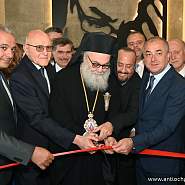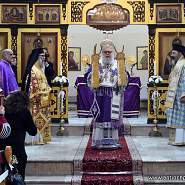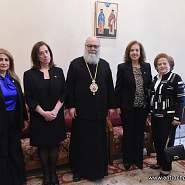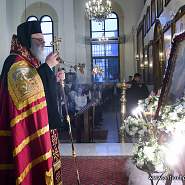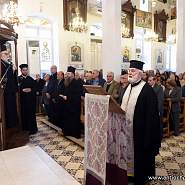Cherubim – Saydnaya Patriarchal Monastery
Cherubim – Saydnaya Patriarchal Monastery
The monastery of the Cherubim lies at an altitude of 2000 metres on the highest peak of Mount Qalamoun, north of Damascus and eight kilometers from Saydnaya. It occupies one of the most spectacular sites in Syria, overlooking Saydnaya itself and a panorama of mountains, hills, and plains, including the whole region of Damascus, the Biqa‘, and the Hawran. The monastery’s domes and towers are visible from far away.
| Cherubim – Saydnaya Patriarchal Monastery | |
| President: | Rev. Archimandrite John Talli |
| Postal Address: | St George Monastery, P.O. Box 22458 Saydnaya, Syria |
| Tel: | +963 11 595 3 377 |
| Fax: | +963 11 595 0 629 |
| E-mail: | [email protected] |
| WebSite: | www.msgchp.com |
The landscape here is arid, with only a thin layer of grass and scrub. In winter, temperatures on Mount Qalamoun are freezing and the summits are covered with snow, but the fresh air gives a most pleasant climate during the rest of the year. In recent years, the monastery has become a popular place of pilgrimage and tourism, encouraged by the recently improved road leading up from Saydnaya.
Deir Mar Sharubin, as local people call it, is dedicated to the cherubim and seraphim, the highest ranks of angels, who occupy the summit of the celestial hierarchy. They first appear in Genesis 3:24, and the most detailed description of them is given by the prophet Ezekiel 1:5-10. In their close relationship with God, the cherubim reflect the glory of the Almighty: images of two cherubim were placed above the Ark of the Covenant (Psalms 66:2, 103:29, Ezekiel 21:2, 1 Peter 1:12); the Almighty is described as enthroned upon the cherubim (1 Kings 4:4, Psalms 17:11, Isaiah 37:16), and they are seen as standing before the heavenly throne of God (Revelation 4:1-8, Isaiah 66:15, Ezekiel 1:4, 43:2-4).
Monastic activity at the Cherubim monastery began only in 2003, under the patronage of St George’s Monastery, Saydnaya, and its new superior, Youhanna al-Talleh. Four novices now live here under the direction of brother Nectarius Dahdal. Together with the seven monks at St George’s, they are working on the reconstruction of the monastery. In less than a decade, the Cherubim monastery has been transformed into an impressive religious center that regularly welcomes large numbers and holds summer camps for young people from all over Syria.
History
The monastery’s origin is unknown, but it certainly goes back to ancient times. Remains of late antiquity have been found among its ruins, and local tradition holds that the monastery was founded in the fifth century. Several caves with stepped entrances have been dug into the hillside nearby. They are thought to be prehistoric, but they were probably re-used by early Christians for refuge and seclusion. As at St George al-Homeyra in Syria or at Hamatoura and Kaftoun in Lebanon, the presence of large numbers of monks in these caves led in time to the foundation of a monastery.
The first extant record of the monastery appears in the work of the fourteenth-century Arab author Chehab al-Din al-‘Umari, who states that it was built by the Byzantines and describes its white limestone construction and architecture. [1] In 1737, the English visitor Bishop Richard Pococke found a single monk living at the Cherubim monastery, which he calls the monastery of St Sergius; nevertheless, he writes, the church was in good condition and still functioning.[2] But in the middle of the eighteenth century, according to the historian Asad Rustom, the last three aged monks left the Cherubim monastery for Our Lady of Saydnaya. Since then, the monastery gradually fell into ruin: visiting in the 1920s, Rustom records masses of stones, columns, and fragments of sculpture scattered across the hillside.
When Catherine Abou Haidar, mother superior of Our Lady of Saydnaya, visited the site in 1945, she conceived the idea of restoring the monastery and reviving monastic life there.[3] But almost forty years passed before her aim was realized. Building work eventually began in 1983, the church was inaugurated a little later, and new buildings have continued to rise since then.
Architecture
All we know about the monastery’s appearance in former times comes from Pococke’s brief description, and the planners of the modern monastery adopted this information as a basis for the church’s reconstruction. They utilized the building stones of the old church and, as far as possible, tried to restore the original site, plan, and architecture.
The church is impressive from a distance, resembling medieval churches of Mount Lebanon. The entrance porch is formed of three columns, which support a concrete entablature and roof incorporating ancient decorative elements. The rest of the building is formed of original stones in regular courses. However, the highly visible cement binding detracts from the beauty of the structure, as does the modern stone triangle in the façade.
The interior is simple and compact. The bare walls reveal the ancient stones, which contrast strikingly with the flat concrete ceiling. The modern stone iconostasis blocks the entire east end. It displays contemporary icons, and images of Jesus’ life cover sections of the walls.
An exceptionally high bell-tower has recently been built just behind the church near a great cliff. It is formed of several cubic blocs, diminishing in size to create an elongated pyramid. The heavy lower sections lack openings, but the upper part has arcades on all sides. The tower is positioned on the highest point of the monastic grounds and is visible from a great distance. Nearby are two masonry crosses of differing sizes. Rock-cut stairs lead to these monuments, from where a marvelous panorama of hills and plains is revealed.
To the north of the church is a large building reserved for visitors and pilgrims. The ground floor is built of ancient stones and the three upper floors are faced by arcaded galleries. As in the bell-tower, these floors reduce progressively in width to create an impressive pyramidal shape. Two great salons at ground-floor level are furnished all around with chairs and settees. The large numbers of guests who regularly gather in these rooms are generously served with seasonal fruits, tea, coffee, sweets, and biscuits. The upper floors contain twenty-two bedrooms, which are filled during the summer months.
On either side stand two smaller buildings of the same pyramidal form. One contains a library and other rooms reserved for the monks, and the other contains the monks’ cells. Behind these again is another building of several floors, still under construction. It will be divided into monks’ cells and rooms for visitors’ reception and accommodation.
The monastery owns about 700 hectares of cultivable land to the north and west. A small part of this land has been planted with an orchard containing apple, cherry, apricot, and other trees; cypresses grow near the monastery itself, and the visitors’ building is surrounded by gardens. Finally, a hermitage recently built from ancient stones lies beside the orchard. Upon a ruined site, an Orthodox monastery has been newly founded for monks, pilgrims, and visitors desiring to pray and meditate or simply to enjoy the calm and majestic beauty of this ancient hilltop site.
[1] Masalik al-absar fi jumlat diyarat al-sham, 356.
[2] Pococke, Richard, Description of the East (London, 1745), vol. II, part 1, p.134.
[3] Azar al-Zahr, Cherubim Monastery of Saydnaya (Damascus, 2004), 11.

2024-04-18
2024-04-14
Sunday Liturgy of Saint John…
2024-04-12
His Beatitude Receives a…
2024-04-12
The Fourth Akathist Prayer in…
2024-04-11
Great Compline Prayer in Jdeidat…



